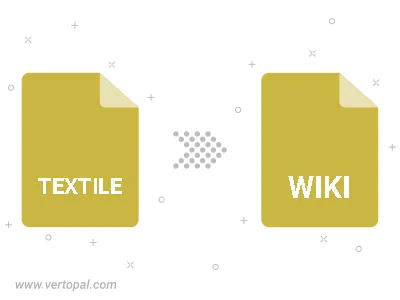Convert TEXTILE to WIKI XWIKI
Convert TEXTILE markup documents to WIKI XWIKI format, edit and optimize documents online and free.

The TEXTILE file extension, an acronym for Textile Markup Language, is a lightweight markup language developed by Dean Allen in 2002. It converts plain text into structured HTML, making it useful for writing articles, forum posts, and documentation. Textile is known for its simplicity and readability, and it has influenced the development of other markup languages like Markdown.
The XWiki Markup Language (WIKI) file extension is used in XWiki, an open-source enterprise wiki and collaborative platform. It facilitates the creation and formatting of wiki pages, enabling text formatting, embedding images, creating tables, and linking to other pages. The syntax was introduced to simplify content management and enhance collaboration. Over time, it has evolved to include advanced features like macros and scripting capabilities. This extension is integral to XWiki's functionality, supporting a wide range of applications from knowledge management to project documentation.
Start uploading a TEXTILE markup document by clicking the Choose File button or drag & dropping your TEXTILE file.
To customize TEXTILE to WIKI XWIKI conversion, use the available tools before clicking the Convert button.
Wait a couple of seconds for the converter to do the hard job, then download your WIKI XWIKI file.

To change TEXTILE format to WIKI XWIKI, upload your TEXTILE file to proceed to the preview page. Use any available tools if you want to edit and manipulate your TEXTILE file. Click on the convert button and wait for the convert to complete. Download the converted WIKI XWIKI file afterward.
Follow steps below if you have installed Vertopal CLI on your macOS system.
cd to TEXTILE file location or include path to your input file.Follow steps below if you have installed Vertopal CLI on your Windows system.
cd to TEXTILE file location or include path to your input file.Follow steps below if you have installed Vertopal CLI on your Linux system.
cd to TEXTILE file location or include path to your input file.